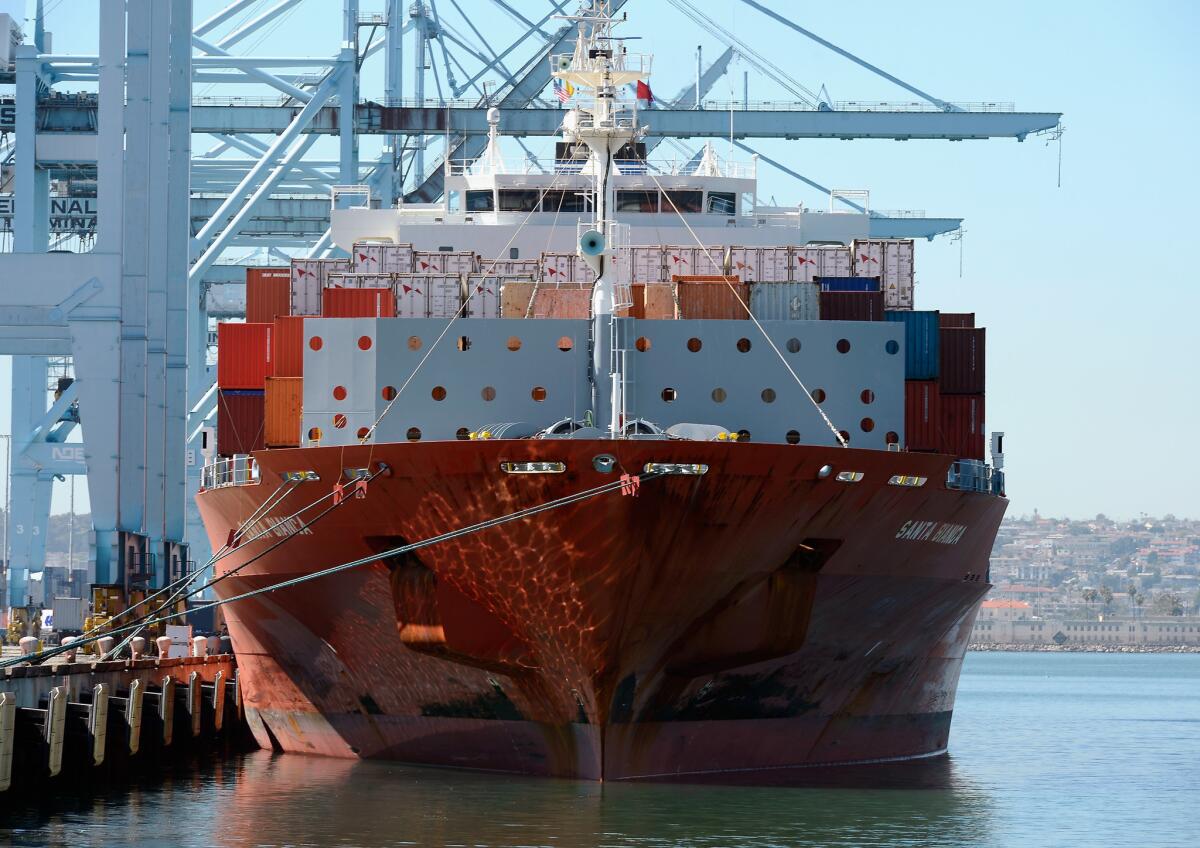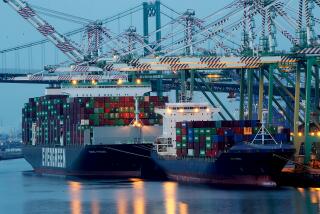Newton: What about the Port of Los Angeles?

It’s fun for mayoral candidates to imagine eliminating potholes or building new trains to link the Valley to the Westside. It’s not hard to support a spiffed-up LAX (really, what’s hard to believe is that it’s taken this long) or legions of new police officers making Los Angeles safe. What you don’t often hear from these candidates, however, is a thoughtful vision for the Port of Los Angeles.
The port can seem far away, but it’s crucial to the city’s life. Every year, more than $250 billion worth of cargo passes through its 7,500 acres of docks and cranes. Cruise ships load and unload. The battleship Iowa is docked there. The cargo alone is enough to support nearly 1 million jobs in Southern California and about 3.6 million nationally. As an industry, it makes Hollywood seem trivial.
Given that, you might think both mayoral candidates would have volumes to say about how they plan to run this facility. Nope.
ENDORSEMENTS: Los Angeles City Elections 2013
Controller Wendy Greuel recently released her comprehensive “Leading L.A. Forward,” an impressive and detailed menu of her policy prescriptions for balancing the city budget, creating jobs and reforming education, among other things.
But here’s all it says about the port: “I will work closely with … the Port of Los Angeles to expedite green-growth projects that will position the port to compete in the face of the Panama Canal expansion.”
And Councilman Eric Garcetti’s summary of his “record and agenda” doesn’t mention the port at all.
WATCH: Garcetti video interview | Greuel video interview
Outgoing Mayor Antonio Villaraigosa can point to his stewardship of the port with pride — traffic plummeted at the outset of the recession but has steadily climbed. Emissions have been dramatically reduced. But there’s still room for improvement. Some port customers complain that projects take too long to approve, and some Long Beach residents and leaders feel Villaraigosa has treated them high-handedly.
The good news is that the management of the port is capable and on the case. Under the leadership of Geraldine Knatz, its executive director, the port has compiled a five-year plan to keep the facility competitive while maintaining its relationships with customers and neighbors and building on its financial strength.
That’s a sound start, but the future will be complicated. Even as the port is preparing to accommodate larger ships that will soon pass through the widened Panama Canal, Knatz warns that some cargo from Southern Asia is turning west and making its way through the Suez Canal. At the same time, shipyards are upgrading on the west coast of Canada and Mexico, both eager to pick off Pacific traffic.
PHOTOS: A rogues’ gallery of L.A. mayors
“You can’t just focus on one thing,” Knatz said of the shipping business. “You’ve got to watch your back.”
It’s a constant struggle to supply shippers with efficient berths and ready access to the national rail network. As long as shippers have those, they can unload quickly and disperse their goods across North America.
But there are other concerns. Port traffic creates jobs but also congestion and air pollution as trucks shuttle cargo from the docks to the closest rail yards. Today, that means a 24-mile trek up the 710 Freeway.
A much-debated proposal to build a new yard just a few miles from the port would create shorter trips and reduce air pollution but concentrate loading activity in Wilmington. The next mayor will need to find ways to help the area balance the economic and environmental benefits of the rail yard with the concerns of neighbors.
Garcetti has shown an inclination to flinch in the face of pressure, recently announcing that he would not favor the reconfiguration of the north runway at LAX, which is opposed by neighbors. He hedged a bit last week on the port rail yard project, saying he supported it but wanted some more details about displaced jobs and zero-emission trucks.
Greuel was in about the same place: She supports it, while also saying she wants to mitigate negative effects.
That’s a frustrating microcosm of the campaign: Both support it. Sort of.
There are real issues needing the mayor’s attention at the port. When automated cranes were installed there a few years ago, for instance, Villaraigosa transferred safety responsibility from the city’s Building and Safety Department, which had no expertise in that machinery, to the harbor staff, which did. That small shift expedited the project and helped keep the port competitive.
City Councilman Joe Buscaino represents the area and knows it well. He said the next mayor — Buscaino has endorsed Garcetti — needs to focus on keeping the port competitive, protecting the environment and developing the waterfront from San Pedro to Wilmington. The port must respect its neighbors, he stressed, but it must thrive as a business too.
“The port is a huge asset,” Buscaino said. “We have to make sure it’s competitive.”
Jim Newton’s column appears Mondays. His latest book is “Eisenhower: The White House Years.” Reach him at jim.newton@latimes.com or follow him on Twitter: @newton_jim.
More to Read
A cure for the common opinion
Get thought-provoking perspectives with our weekly newsletter.
You may occasionally receive promotional content from the Los Angeles Times.











